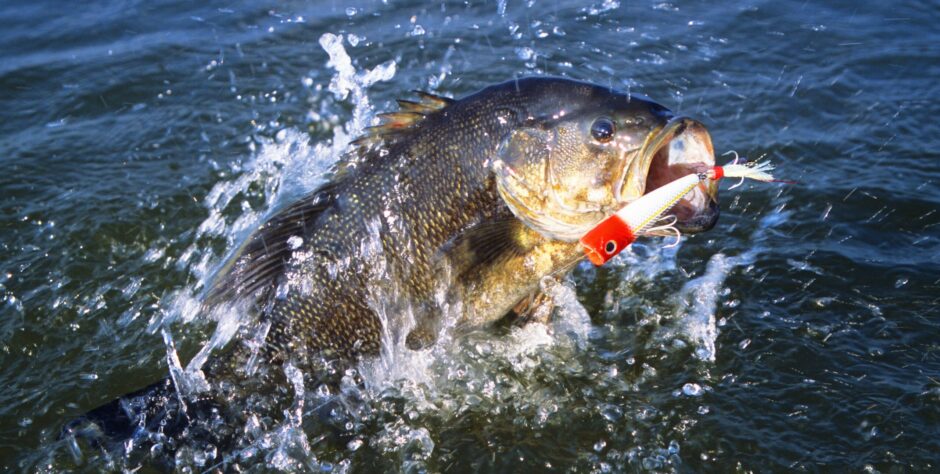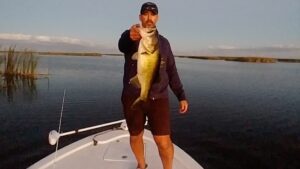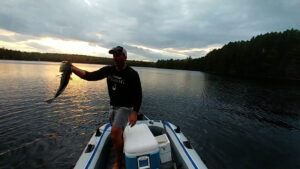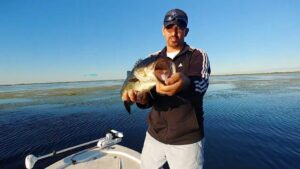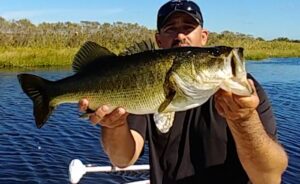Smallmouth bass can be found in many different types of lakes and reservoirs. On the larger lakes and reservoirs, there are a variety of factors that will dictate where the bass will be throughout the season. Figuring out smaller lakes is easier, but there is still plenty to learn if you want to consistently catch more fish.
Seasonal Migrations
Smallmouth bass can be found in bays, along shorelines and shallow flats as they get ready to spawn. Hard bottom areas with some sand and/or rock will hold fish. There are a variety of baits that will work for bass in the shallows.
When the bass finish spawning, the females will move deeper as the males stay back to guard the nest. Fishing can be difficult for trophy fish during this time period, but once the big females recover from the spawn, they will put the feed back on. The summer pattern for smallmouth bass typically consists of fishing drop-offs along shorelines, points that offer deep water, deep water humps and open water. While most bass are caught in 15 to 30 feet of water during the summer, some anglers fish for suspended bass over 50 to 100 feet of water. This is not easy fishing, but it can be productive if you put in the time and have good electronics that will help you find the schools of bait fish.
Smallmouth bass are known for roaming many miles during the summer months as they search for schooling bait fish offshore. Some fish can still be found shallow near some type of cover or on a shallow flat during the morning, evening and through the night, but most of the bigger bass will be found offshore in the summer.
During the fall, bass can be found shallow and deep. Early fall usually brings some fish back into shallow water, but once the water temperatures drop into the low 50s and upper 40s, smallmouth bass can be found schooling up in deeper water. Deep drop-offs and points will usually hold good numbers of smallmouth bass and if you can find the schools, you can fill your limit in a hurry.
Drop-Offs
Smallmouth bass can consistently be found on the drop-offs during the early spring, summer and fall months. When bass come in the shallows to spawn, you may experience much better fishing shallow, but after the spawn, the deeper water bite tends to be much better on most waters for trophy-sized smallmouth bass.
Smallmouth bass definitely relate to the drop-offs, but the steeper drop-offs usually hold more fish. When fishing the deeper water, try to find hard bottom such as rocks and sand. These hard bottom areas will hold more smallmouth bass. To consistently catch smallmouth bass in deeper water, you need to learn how to fish vertical. Drop-shot rigs fished with soft plastics and live bait is the most popular way to fish the drop-offs for smallmouth bass. In clearer water, you may also want to go with lighter line (4 to 8 pound test), a light action rod and fluorocarbon line to help you get more strikes.
Flats
Fishing the flats can be just as productive as fishing the drop-offs for smallmouth bass. During the spring, smallmouth bass will come onto the flats in bays and along shorelines to get ready to spawn. If you are fishing in clear water, the sight fishing can be unbelievable during this time of year. Swimming grubs and tubes can be very effective for active bass on the flats during the spring. Once bass are on the beds, tubes, grubs and soft plastics work well, but you may need to jig them repeatedly in the bed to get a strike. Shaky head jigs and even drop-shot rigs can help you twitch your bait without moving it out of the bed. A quick catch and release is key for getting the big females back on their beds without doing them any harm.
Once the spawn is over and the fish move deeper, the better fishing will usually occur in deeper water, but the flats can still provide some good fishing for smallmouth bass very early in the morning, just before dark and at night. The better flats during the summer and fall are the flats that have rocks and nice deeper water nearby.
Docks
The docks are some of the best places to fish during the spring for smallmouth bass. Find some hard bottom with a nice sand and rock mix and you should find some smallmouth bass. You can find smallmouth bass around the docks in the summer and fall too, but you need some deep water there or you will most likely just find small fish.
Points
Points are some of the best places to catch smallmouth bass. You can find bass on the points from spring through fall. The best points have some type of hard bottom with some shallow water and deep water. A steep drop off will likely hold more smallmouth bass, but a gradual drop-off is fine as long as there is some water that drops into the 16 to 20 foot depths. The points with deep water nearby will hold more fish through the summer and fall months while the shallow water points will not hold as many fish. You can use a variety of techniques when fishing points. Some of the common baits are tubes, jigs, grubs, soft plastics, crankbaits, spinnerbaits and live bait.
Reefs
Fishing for smallmouth bass on reefs can be very productive. Depending on the lake you are fishing, you may or may not have the option of fishing a reef. The Great Lakes and other large lakes up north are known for having reefs. In spring, you may find some smallmouth bass around the reefs, but the summer and fall months is when you will usually find the large schools of smallmouth bass around the reefs.
During the summer and fall, smallmouth bass can often be found on top of the reefs, along the drop-offs running off the reefs and at times, suspended in open water very close to the reefs. When you can find reefs with lots of rock and some deep water nearby, you will most likely find some smallmouth bass. Some of these reefs will have 20 to 30 feet of water with water as shallow as 4 feet just a cast away. The reefs that offer a good mixture of shallow water and steep drop-offs tend to hold the most smallmouth bass. The shallow water will usually hold some bass in the early morning, evening and at night. The deeper water is where you will usually catch better numbers of smallmouth bass, especially if you are looking for bigger bass. It is not uncommon to catch smallmouth bass anywhere from 20 to 40 feet deep in clear water lakes.
Rocks & Boulders
Smallmouth bass absolutely love rocks and boulders. They spend more time along rocks and boulders than any other type of cover. These areas provide plenty of food such as insects, bait fish and crayfish. Smallmouth bass are often found near the bottom along rocky areas so tubes, jigs and soft plastics worked near the bottom can be very effective. During low-light conditions, smallmouth bass are known to come as shallow as 1 to 2 feet to search for crayfish in the rocks. When the sun gets high in the sky, smallmouth bass are usually found much deeper. It is not uncommon for anglers to catch smallmouth bass in 20 to 30 feet of water in clear water lakes. Whether you fish the rocks in deep or shallow water, you will definitely catch more smallmouth bass by targeting them in the rocks.
Weeds
Smallmouth Bass can be found in the weeds, although they would much rather prefer a sand or rock bottom. Fishermen that catch largemouth bass in the weeds need to realize that smallmouth bass will not be around the weeds as much as largemouth and the types of weeds will differ just a bit. Smallmouth Bass love firm bottoms, so finding weeds in areas that have a hard bottom are key for catching smallmouth in the weeds. Soft bottoms usually won’t hold many smallmouths, so focus your time on the hard bottom areas with weeds. Smallmouth also like weeds that are low growing or scattered. To catch smallmouth in these areas, you can probably get away with 8 to 12 pound test line.
On lakes that don’t have a lot of rock, you can expect to find good numbers of smallmouth bass along the deep weed line from summer through fall. On lakes that have a lot of rock and weeds, you will usually find more bass along the rocks, but don’t rule out the weeds, especially the deeper weed edges.
Wood
Smallmouth bass may not prefer wood to rock, but they definitely do like wood. Wood provides excellent cover as well as plenty of bait fish and insects for food. Just like with weeds, the best wood areas that hold smallmouth also have a hard bottom with a boulder or some rocks. When you’re looking for good wood areas that will hold smallmouth, try to find wood that offers lots of protection overhead, a hard bottom, deep water nearby and the more tree limbs that go in the water the better.
Jigs and live bait work best around wood. Flippin’ or pitchin’ a jig will help you get in the tough spots. When you can’t get them to hit a lure, a drop shot rig with some live bait will usually get them to eat. Some anglers like to use soft plastics and topwater baits around wood. These can also be very effective.
